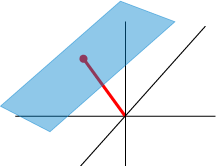Section4.2Week 8 (Jul 16-20)
This week, we'll begin to significantly shift gears. Up to this point we've been mostly concerned with the algebraic properties of linear transformations, asking algebra-like questions about their matrices (how many pivots? is it invertible? is the transformation one-to-one?). Now, we want to ask more geometric questions about transformations instead. For a transformation of the xy-plane, for example, we want to ask things like:
- Does this transformation tend to make areas bigger, or smaller? By how much?
- Does this transformation reverse the orientation of shapes (i.e., make them into a mirror image)? Or does it preserve them?
- Does this transformation stretch the lengths of vectors? Shorten them? Which vectors, and by how much?
These are questions we'll answer by computing the determinants of square matrices, and then using determinants we'll also be able to look for eigenvectors of those matrices. So:
- Does this transformation make areas bigger or smaller? By how much? Answer: \(\bigl| \det A \bigr|\) is the factor by which areas are multiplied by this transformation.
- Does this transformation reverse orientation, or preserve it? Answer: if \(\det A \gt 0\text{,}\) orientation is preserved. If \(\det A \lt 0\text{,}\) orientation is reversed.
- Does this transformation stretch the lengths of vectors? Which vectors, and by how much? Answer: \({\bf v}\) is an eigenvector of \(A\) if \(A\) exactly stretches \({\bf v}\) by a constant scaling factor, i.e. if there is a scalar \(\lambda\) for which \begin{gather} \boxed{ A {\bf v} = \lambda {\bf v}.}\tag{4.2.1} \end{gather}
The so-called eigenvector-eigenvalue equation (4.2.1) will quickly become our new focus, replacing \(A{\bf x} = {\bf b}\) as the chief equation of study in the second half of our course.
To do this week:
NOTE: Portfolio 4 will be combined with Portfolio 3. Continue to keep copies of your best work on each learning standard to prepare for submission of a cumulative portfolio (containing all of Chapters 1-4) upon Portfolio 4's due date.
By Monday 7/16:
- Submit Quiz 7 via Blackboard.
By Tuesday 7/17:
- Read and annotate 3.4: Determinants https://via.hypothes.is/http://merganser.math.gvsu.edu/david/linear.algebra/ula/ula/sec-determinants.html
- Read and annotate 4.1: Introduction to eigenvalues and eigenvectors https://via.hypothes.is/http://merganser.math.gvsu.edu/david/linear.algebra/ula/ula/sec-eigen-intro.html
By Wednesday 7/18:
- Submit Quiz 8 via Blackboard.
By Thursday 7/19:
- Submit Quiz 7R via Blackboard.
By Friday 7/20:
- Record a video explaining your emerging understanding of determinants via Flipgrid: https://flipgrid.com/631c19 (password linearalgebra).
By Monday 7/23:
- Submit Quiz 8R via Blackboard.
Subsection4.2.1Determinants and Changing Area
Subsection4.2.2Two Methods for Computing Determinants
Subsection4.2.3Introduction to Eigenvectors
This is one of Dr. S' most popular single videos on YouTube.
